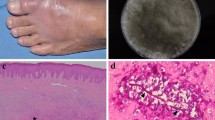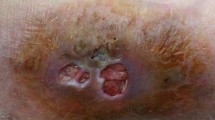Abstract
Hyalohyphomycosis is an unusual opportunistic mycotic infection where the tissue morphology of the causative organism is mycelial. Etiological agents, which are not responsible for the otherwise-named infections like aspergillosis, are the species of non-dematiaceous hyaline hyphomycetes including Penicillium, Paecilomyces, Acremonium (formerly known Cephalosporium), Beauveria, Fusarium, and Scopulariopsis. Several cases of Acremonium infection have been described in immunocompromised patients; however it can cause invasive disease in an immunocompetent person very rarely. Optimum therapy of Acremonium infection is unclear because of the limited number of reported cases and conflicting results of therapies. Imiquimod, an imidazoquinoline with potent antiviral, antitumor and immunoregulatory properties, is currently approved for the topical treatment of external anogenital warts and actinic keratosis. Imiquimod has also been found to be effective for other virus-associated dermatologic lesions, including common and flat warts, molluscum contagiosum, and herpes simplex virus type-2 as well as for some cases of cutaneous leishmaniasis. We report herein, for the first time, a case of unusually recalcitrant hyalohyphomycosis of the face due to Acremonium strictum successfully treated with topical 5% imiquimod in an immunocompetent patient, who had failed to respond to various antifungals, including itraconazole, and cryotherapy.
Similar content being viewed by others
References
MK Schinabeck MA Ghannoum (2003) ArticleTitleHuman hyalohyphomycoses: a review of human infections due to Acremonium spp., Paecilomyces spp., Penicillium spp., and Scopulariopsis spp J Chemother 15 IssueIDSuppl 2 5–15
A Nedret Koc F Erdem T Patiroglu (2002) ArticleTitleCase Report. Acremonium falciforme fungemia in a patient with acute leukaemia Mycoses 45 202–203 Occurrence Handle10.1046/j.0933-7407.2002.00746.x Occurrence Handle1:STN:280:DC%2BD38zlslKjtQ%3D%3D Occurrence Handle12100541
P Vasiloudes JG Morelli WL Weston (1997) ArticleTitlePainful skin papules caused by concomitant Acremonium and Fusarium infection in a neutropenic child J Am Acad Dermatol 37 1006–1008 Occurrence Handle1:STN:280:DyaK1c%2FotVSjsw%3D%3D Occurrence Handle9418778
RM Fincher JF Fisher RD Lovell et al. (1991) ArticleTitleInfection due to the fungus Acremonium (cephalosporium) Medicine (Baltimore) 70 398–409 Occurrence Handle1:STN:280:By2D28rnvFE%3D
SF Kan TH Tsai CH Hu WR Lee (2004) ArticleTitleCutaneous hyalohyphomycosis caused by Acremonium in an immunocompetent patient Br J Dermatol 150 789–790 Occurrence Handle10.1111/j.0007-0963.2004.05896.x Occurrence Handle15099392
R Anadolu S Hilmioglu T Oskay et al. (2001) ArticleTitleIndolent Acremonium strictum infection in an immunocompetent patient Int J Dermatol 40 451–453 Occurrence Handle10.1046/j.1365-4362.2001.01220.x Occurrence Handle1:STN:280:DC%2BD3Mrnt1Omtg%3D%3D Occurrence Handle11679001
C Zaitz E Porto EM Heins-Vaccari et al. (1995) ArticleTitleSubcutaneous hyalohyphomycosis caused by Acremonium recifei: case report Rev Inst Med Trop Sao Paulo 37 267–270 Occurrence Handle1:STN:280:BymD2crotVw%3D Occurrence Handle8525275
SM Garland (2003) ArticleTitleImiquimod Curr Opin Infect Dis 16 85–89 Occurrence Handle1:CAS:528:DC%2BD3sXitF2htL4%3D Occurrence Handle12734440
RB Skinner (2003) ArticleTitleImiquimod Dermatol Clin 21 291–300 Occurrence Handle10.1016/S0733-8635(02)00094-3 Occurrence Handle1:CAS:528:DC%2BD3sXjvFOgsb4%3D Occurrence Handle12757252
I Arevalo B Ward R Miller et al. (2001) ArticleTitleSuccessful treatment of drug-resistant cutaneous leishmaniasis in humans by use of imiquimod, an immunomodulator Clin Infect Dis 33 1847–1851 Occurrence Handle10.1086/324161 Occurrence Handle1:CAS:528:DC%2BD3MXpt1Kjt7s%3D Occurrence Handle11692295
B Berman VN Poochareon AM Villa (2002) ArticleTitleNovel dermatologic uses of the immune response modifier imiquimod 5% cream Skin Therapy Lett 7 1–6 Occurrence Handle1:STN:280:DC%2BD3s%2FktVKgtw%3D%3D
TJ Walsh A. A Groll J Hiemenz et al. (2004) ArticleTitleInfections due to emerging and uncommon medically important fungal pathogens Clin Microbiol Infect Clin Microbiol Infect 10 IssueIDSuppl 1 48–66 Occurrence Handle10.1111/j.1470-9465.2004.00839.x
J Chander A Sharma (1994) ArticleTitlePrevalence of fungal corneal ulcers in northern India Infection. 22 207–209 Occurrence Handle10.1007/BF01716706 Occurrence Handle1:STN:280:ByqD3M3ns1Y%3D Occurrence Handle7927819
MW Lee JC Kim JS Choi et al. (1995) ArticleTitleMycetoma caused by Acremonium falciforme: successful treatment with itraconazole J Am Acad Dermatol 32 897–900 Occurrence Handle10.1016/0190-9622(95)91557-5 Occurrence Handle1:STN:280:ByqB3sfms1A%3D Occurrence Handle7722053
ZB Pontes O Lima Ede NM Oliveira et al. (2002) ArticleTitleOnychomycosis in Joao Pessoa City, Brazil Rev Argent Microbiol 34 95–99 Occurrence Handle12180263
D Mattei N Mordini C Lo Nigro et al. (2003) ArticleTitleSuccessful treatment of Acremonium fungemia with voriconazole Mycoses 46 511–514 Occurrence Handle10.1046/j.0933-7407.2003.00924.x Occurrence Handle1:STN:280:DC%2BD3srntVKitw%3D%3D Occurrence Handle14641626
J Guarro W Gams I Pujol J Gene (1997) ArticleTitleAcremonium species: new emerging fungal opportunists – in vitro antifungal susceptibilities and review Clin Infect Dis 25 1222–1229 Occurrence Handle1:CAS:528:DyaK2sXnslyrtr4%3D Occurrence Handle9402385
P Manzano-Gayosso F Hernandez-Hernandez LJ Mendez-Tovar et al. (2003) ArticleTitleFungal peritonitis in 15 patients on continuous ambulatory peritoneal dialysis (CAPD) Mycoses 46 425–429 Occurrence Handle10.1046/j.0933-7407.2003.00922.x Occurrence Handle1:STN:280:DC%2BD3srlvFGrtQ%3D%3D Occurrence Handle14622394
S Buates G Matlashewski (1999) ArticleTitleTreatment of experimental leishmaniasis with the immunomodulators imiquimod and S-28463: efficacy and mode of action J Infect Dis 179 1485–1494
L Scaringi E Rosati P Cornacchione et al. (1995) ArticleTitleLocal and systemic immune response to inactivated Candida albicans in mice Nat Immun 14 234–249 Occurrence Handle1:CAS:528:DyaK28XmslKqsbk%3D Occurrence Handle8933818
E Ortega I Algarra MJ Serrano et al. (2000) ArticleTitleEnhanced resistance to experimental systemic candidiasis in tilorone-treated mice FEMS Immunol Med Microbiol 28 283–289 Occurrence Handle10.1016/S0928-8244(00)00168-1 Occurrence Handle1:CAS:528:DC%2BD3cXks12rurw%3D Occurrence Handle10891651
AG Palma-Carlos ML Palma-Carlos (2001) ArticleTitleChronic mucocutaneous candidiasis revisited Allerg Immunol (Paris) 33 229–232 Occurrence Handle1:STN:280:DC%2BD3MvmtFGqsA%3D%3D
K Kawakami Y Koguchi MH Qureshi et al. (2000) ArticleTitleNK cells eliminate Cryptococcus neoformans by potentiating the fungicidal activity of macrophages rather than by directly killing them upon stimulation with IL-12 and IL-18 Microbiol Immunol 44 1043–1050 Occurrence Handle1:CAS:528:DC%2BD3MXnslaltw%3D%3D Occurrence Handle11220678
R Krishnaraj A Svanborg (1993) ArticleTitleLow natural killer cell function in disseminated aspergillosis Scand J Infect Dis 25 537–41 Occurrence Handle1:STN:280:ByuD28bivFY%3D Occurrence Handle8248758
H Akiba Y Motoki M Satoh K Iwatsuki F Kaneko (2001) ArticleTitleRecalcitrant trichophytic granuloma associated with NK-cell deficiency in a SLE patient treated with corticosteroid Eur J Dermatol 11 58–62 Occurrence Handle1:STN:280:DC%2BD3M3jtlamtQ%3D%3D Occurrence Handle11174142
Author information
Authors and Affiliations
Corresponding author
Rights and permissions
About this article
Cite this article
Erbagci, Z., Tuncel, A.A., Erkilic, S. et al. Successful treatment of antifungal- and cryotherapy-resistant subcutaneous hyalohyphomycosis in an immunocompetent case with topical 5% imiquimod cream. Mycopathologia 159, 521–526 (2005). https://doi.org/10.1007/s11046-005-5260-z
Received:
Accepted:
Issue Date:
DOI: https://doi.org/10.1007/s11046-005-5260-z




